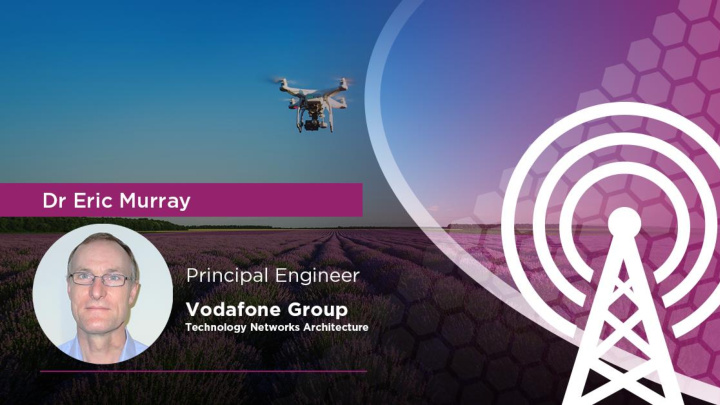



GSMA Internet of Things
Network-based Drone Authentication Through APIs Dr. Eric Murray Vodafone Group Technology 15 July 2020 C1 Public
EU Regulations on Drone Identification • What does EU 2019/945 say? Direct – Direct remote identification is mandatory (for most classes) – Network remote identification is optional • Vodafone and the GSMA worked to ensure the requirement was technology neutral Network • For direct remote identification – Original proposed regulation mandated short-range technologies, such as WiFi or Bluetooth – Now Cellular D2D (Device to Device) can also satisfy the published regulation – This technology is maturing quickly through its use in V2V (Vehicle to Vehicle) use cases • For network remote identification – Cellular is the obvious “network”, but the application data would be transparent to the network – It is expected that the requirements will evolve to include U-space , but still under development Anticipating the evolution of requirements, Vodafone have been working on connecting and authenticating drones to U-space using cellular connectivity C1 Public
How are Cellular Devices currently Authenticated? • IMSI (International Mobile Subscriber Identity) – The primary identifier used for authentication by the cellular network, and very secure – Stored in the SIM, and identifies the subscriber (account owner) and not the device – Used internally by the network for uses such as: – billing and quota enforcement – associating the subscriber with other identities, such as the MSISDN (the “phone” number) – The device itself can be identified by IMEI , but this is not securely authenticated • For voice and SMS, the MSISDN is forwarded to the destination to identify the call originator • But for data services, no unique identifier for the originator is provided – The source IP address is NATed using a shared pool , so not unique to a specific user – The IP address, port and time of use can be used to identify the user retrospectively , but not in real-time – Authentication between client and server is separate from and transparent to the cellular network Whilst client/server authentication could be used to authenticate drones to U-space, network-based authentication offers important security benefits C1 Public
How Might the Requirements for Authenticating Drones Differ? • Not all drone users will be “honest”, and may try to spoof the U -space • Hence the U-space system would like to be sure that: – the connecting device really is a drone – it really is operated by who it says it is – it really is where it says it is – it is connected and remains connected via cellular for the duration of the flight • All of this information is available to the cellular network independently of the drone – The SIM can be registered as a drone SIM – The drone IMSI can be used to cross-reference the drone operator identity – Network-based geo-location techniques (e.g. Vodafone’s Radio Positioning System) can be used to independently estimate the location of the drone – Propagation prediction tools can be used to confirm the proposed flight path has adequate cellular coverage How can the cellular network provide these additional parameters to the U-space? C1 Public
Communicating with U-Space via APIs • The drone communicates with the U-space via an API Gateway within Vodafone’s network – The API gateway adds additional identifying information to the connect request, independently of the drone + Identity + Location Connect Request Flight Authorisation Request + Location Progress Updates U-space API Drone Status Request Gateway (e.g. Coverage, Location) Flight Plan Updates No-Fly Zone Updates, etc. Vodafone’s Network – The U-space can get additional information using additional APIs (e.g. location updates or coverage predictions) – Drone and U-space can exchange information during flight via API Gateway (e.g. status updates, flight plan updates) – The API Gateway authenticates the U-space, and can support multiple U-spaces or changing U-space APIs transparently to the drone. C1 Public
Summary • Cellular D2D technology is one solution for EU “direct remote identification” requirements – This technology is rapidly maturing through its use for Vehicle-to-Vehicle uses cases • But if the drone is also connected to the cellular network, Vodafone can provide secure verification of the drone’s identity to U-space or other systems – The network can also verify parameters such as the drone’s location or predicted coverage quality • By interfacing through a secure API Gateway , this verification is independent of the drone application, and thus not easily spoofed – Equivalent to 2FA, with the second factor provided by Vodafone • An API Gateway also allows U-space systems to evolve without the need to necessarily update the drone client Vodafone have a large programme exposing network capabilities through APIs to support novel use cases C1 Public
Recommend
More recommend